Formal Traits of French Impressionism
Style and Technique
1)These assumptions about the nature of cinema shaped the Impressionist films’ style
and narrative structure. MY NOTE - NARRATIVE SEEMS SECONDARY
2) Most important, filmic techniques often function to convey character subjectivity.
3)This subjectivity includes mental images, such as visions, dreams, or memories;
4) optical point-of-view (POV) shots;
5) and characters’ perceptions of events rendered without POV shots.
6)Though films in all countries had used such devices as superimpositions and flashbacks
to show characters’ thoughts or feelings, the Impressionists went much further in this
direction.
Side note: Superimposition is when two or more image are placed over each other in the frame. ... In narrative film, superimposition is often used for dissolve shots. In Kenneth Anger's experimental film Inauguration of the Pleasure Dome (1954), Anger superimposed up to four images on top of each other.
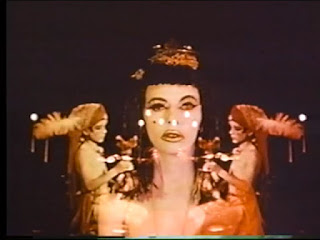
Source and clip
A clip
The 5 C's: pg 137:A dissolve blends one scene into another. Technically, a dissolve is a fade-out superimposed upon a fade-in, so that a loss of image density in the first scene is balanced by a gain in image density in the second scene.
Fade in: A black screen gradually brightens into an image.
Fade out: The image gradually darkens to black.
Fades may be of any length.
Generally employed in pairs.
Side note: Dissolves
What a dissolve does is show time as both brief and long in the same instance — something that is perhaps unique to film as a medium. Dissolves take a moment and “bleed” it into another moment, which gives equal weight to both moments, and takes away our ability to easily distinguished past, present, and future.
Coppola compressed three time periods - the birthday party/pearl Harbor attack in 1941 and this scene the train ride in Sicily in the early 1920s...then Corelone alone in about 1960. We're seeing a third-person style POV...or the memories of Michael Coleone in his final scene.
SourceA better definition and example of a dissolve from Columbia Film Language Glossary - which i will use from now on...
Click her for page
Devices of the Camera - THIS IS PART 1 OF EXAMPLES - PART 2 ON OTHER PAGE
1)The Impressionists were concerned about enhancing the photogénie of their films.
2) Because of this, and because of their interest in character subjectivity,
3) many of the Impressionists’ innovations involve camerawork.
4)Most obviously, Impressionist films frequently contain optical devices that affect the look
of the photographic image.
Such optical devices
1) might be present to enhance the image by making it more striking or beautiful.
2)More often, though, optical tricks convey characters’ impressions.
3)Superimpositions may convey a character’s thought or memories.
4)filter placed over the lens may function to suggest subjectivity,
5)usually without the shot’s being taken from the character’s optical point of view.
In L’Herbier’s Rose-France,
1)an elaborate mask divides the frame into three images,
2)centering the heroine as if in a traditional triptych painting.
Rose-France (Marcel L’Herbier, 1919)
Intertitle:
But during doubt, love stays; and love realizes, transfigures
Fade Outs and Ins one black screen
Intertitle: This is for having forgiveness. This is for every minute late:
A Flower!
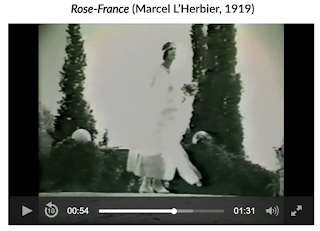
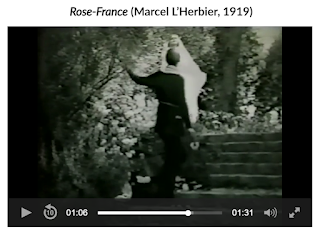
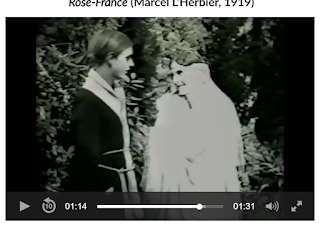
Feu Mathias Pascal
As the hero of L’Herbier’s Feu Mathias Pascal
1)sits in a moving train,
2)we see what he is thinking through a series of images of his village and family,
3)superimposed over the moving train tracks.
Feu Mathias Pascal (Marcel L’Herbier, 1925)
Was that a pan? Yes and pan back to passenger
Intertitles - so pretty
Intertitles say: On this train taking him away from a detestable home life after weeks of mourning, Mathias recalls how he decided to take this liberating trip.
Shot of the railway tracks then superimposed an old house in a plaza with him walking
toward the door. the two shots stay superimposed while he walks
Now a third image is superimposed
The house fades out - the tracks remain.
It is an older man talking to a young? woman. - They lauch
Another shot of himself close up as if looking into the memory superimposes over the tracks and the man and woman talking
The couple fade out and he is still in front of that house from a different angle and the tracks are behind him. It goes on for a while
Another image comes up - perhaps a young him coming out of the same house? still rails
He walks right into the camera
Both end and there is a shot through the window of the people flowing by on the train platform and color film change
The train stops - we see another viewpoint the platform starring at him.
a beautiful view of the platform from the platform
Back to passenger slowly opening the door - it seemed like it opened without him. It also seems like he doesn't know where he is.
He drops his bag.
There is a close-up of the sign Monte Carlo
Back to him in a close-up of just his chest and head.
He's starring and walking out
Intertitle:
Still grief-stricken, he saw everything as if in a dream.
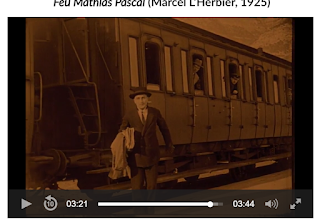
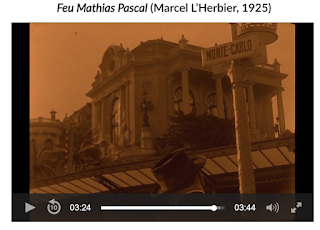
Beautiful city shot of Monte Carlo
Now a beautiful shot of him in front of the Riviera
He kind of shows resignation and decides to go ahead - a little gesture of the eyebrows
NOTE: NOT MUCH NARRATIVE OR INTERTITLES MAINLY VISUAL
In L’Herbier’s
El Dorado, ON YOUTUBE IT SAYS THIS IS PART 6 -
LINK1)the heroine is a performer in a Spanish cabaret.
2)While onstage, she worries about her sick son, and her distraction is suggested by a filter
that blurs her figure but not the women around her.
3)As the other women snap her out of her reverie,
4)the filter disappears and she comes into sharp view. - Actually, this is it and it's not much of a fade...
pulled back shot - funny hat, it says, Sibilla - Seville?
There is also a small begging child or person in the bottom left and a cha cha kind of sound
A sign or intertile popped up for a second "Maison du danse" subtitled House of Dance.
There was a unique transition like two black curtains
Color change
Is this called a long shot - establishing shot?
Yes - in the 5cs it says "Long shots establish area of action and players' positions. Players' entrances, exits and movements should be covered in long shot whenever their location in setting is narratively significant.
Long shots also depict the size of objects such as a jetliner and dwarf players who will be seen to advantage in later medium shots and close-ups. p27
Another one?
We see a new angle through the dome and a side view of the players
and another view with indigenous women?
a close up on a row of Loteria stamps that say Marzo 1921 - i guess to establish language/place?
Back to the arc and the musicians guitars and mustaches
someone playing a tambourine
Not sure if these are dancers or prostitutes - They're flamenco dancers waiting to go on stage the one in the middle leaning down is Sibilla
Women with babies - breastfeeding
Closeup of musicians and some drunk guy
I like the sing and the smoker - altogether.
The cazalla is a type of dry anise, obtained from the distillation of anise. Made exclusively in the town of Cazalla de la Sierra, Andalusia,
In Spain, the drink is commonly known as 'anís' or sometimes as 'Chinchón', while in other parts of the country you can hear the word 'Cazalla' - a name which is also used in certain Arabic countries.
A sign pops up D'exces. English Excess
Closer up of guitar player his chest and part of instrument
Fade out Fade in - lady drinking
Kind of a surreal picture of a guy dropping back a shot and the shot kind of blurry
Another dizzy person drinking and blurred an indigenous woman now smoking a cigarette
Same guy with the shot glass - now blurred. is this a filter?
Close up of piano players hands an overlay of some flowers on a skirt.
now the picture is red - a boss yelling at a woman. is this a filter?
They fight, he makes her leave.
Close up on an old lady, sleeping in a corner.
Intertitle:
The noise increases. The room is full. There is a strong smell ... tobacco and wine.
It looks so nice in French.
Cut to long shot of the band
Cut to the drunk in the corner - dancing alone
Cut to the ladies/prostitutes? playing maracas
Cut to the bad.
Cut to a made up performer?
Intertitle:
Anxious...the soul elsewhere. Sibilla ,one of the dancers
Eve Francis (?)
Intertitle:
C'est a toi, Sibilla! Allons... A toi Sibilla!
It's you, Sibilla! Come on ... you, Sibilla
She dances, they cut a lot to the crowd.
NOTE: GOOD AT EDITS TO CUT TO CROWD AND BACK AND MUSICIANS AND BACK. MUSIC SEEMED TO MATCH
Oh i think it's a different place now - Maison de plaisir
House of pleasure?
Here the feelings conveyed are those of the heroine,
and the shot is not taken from anyone’s point of view.
El Dorado (Marcel L’Herbier, 1921)














































No comments:
Post a Comment